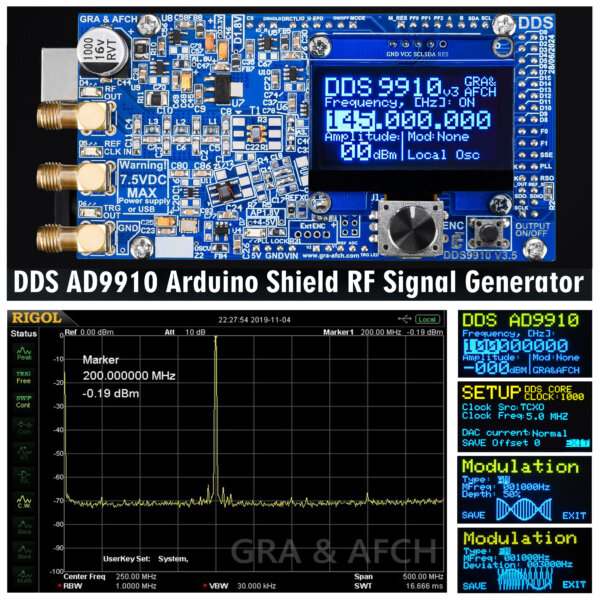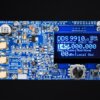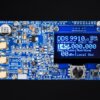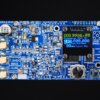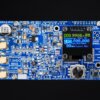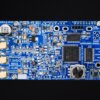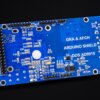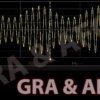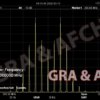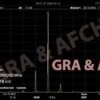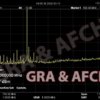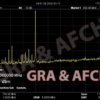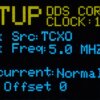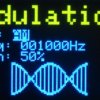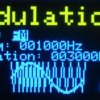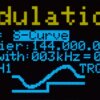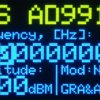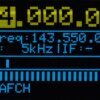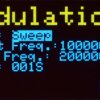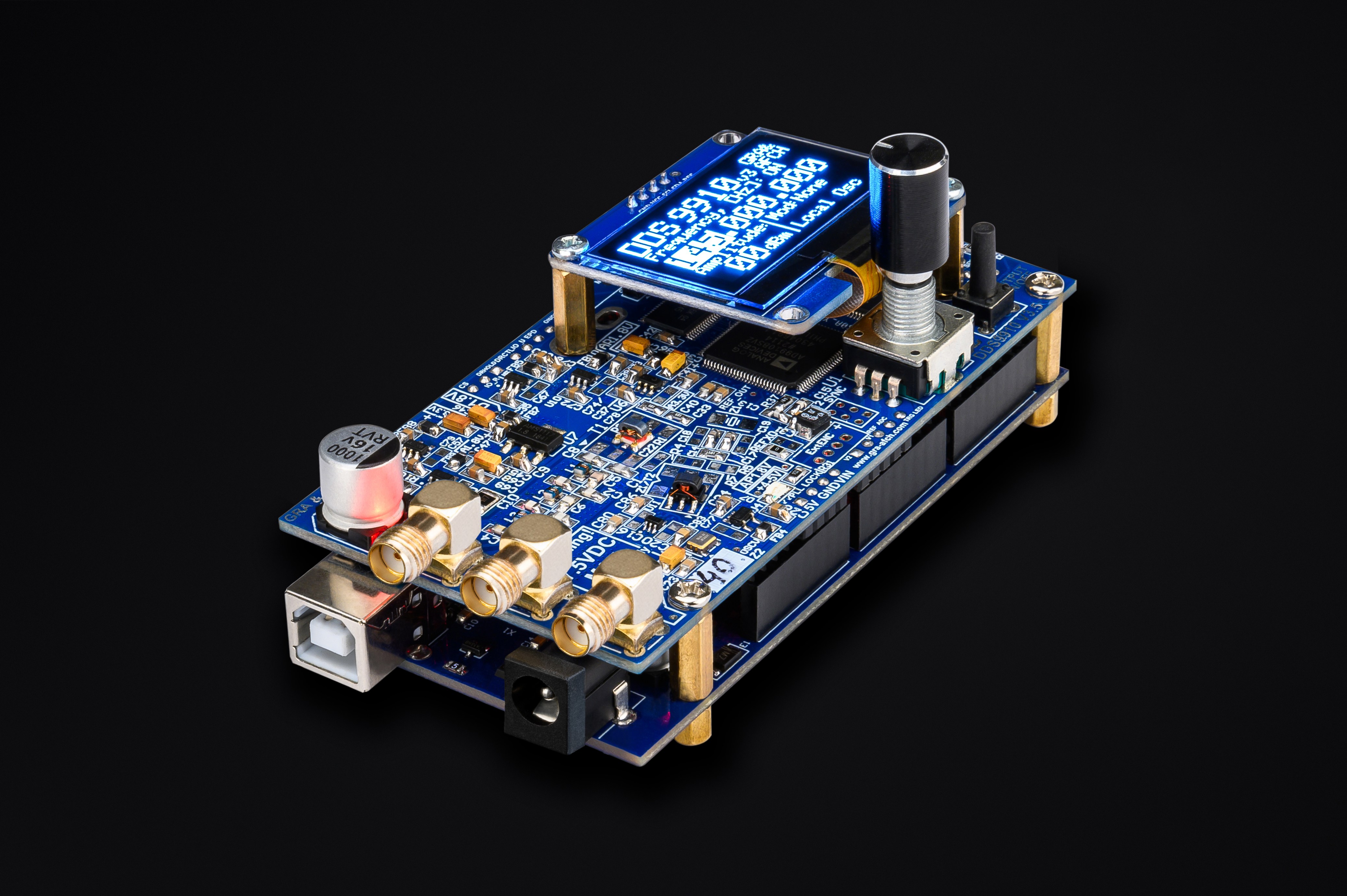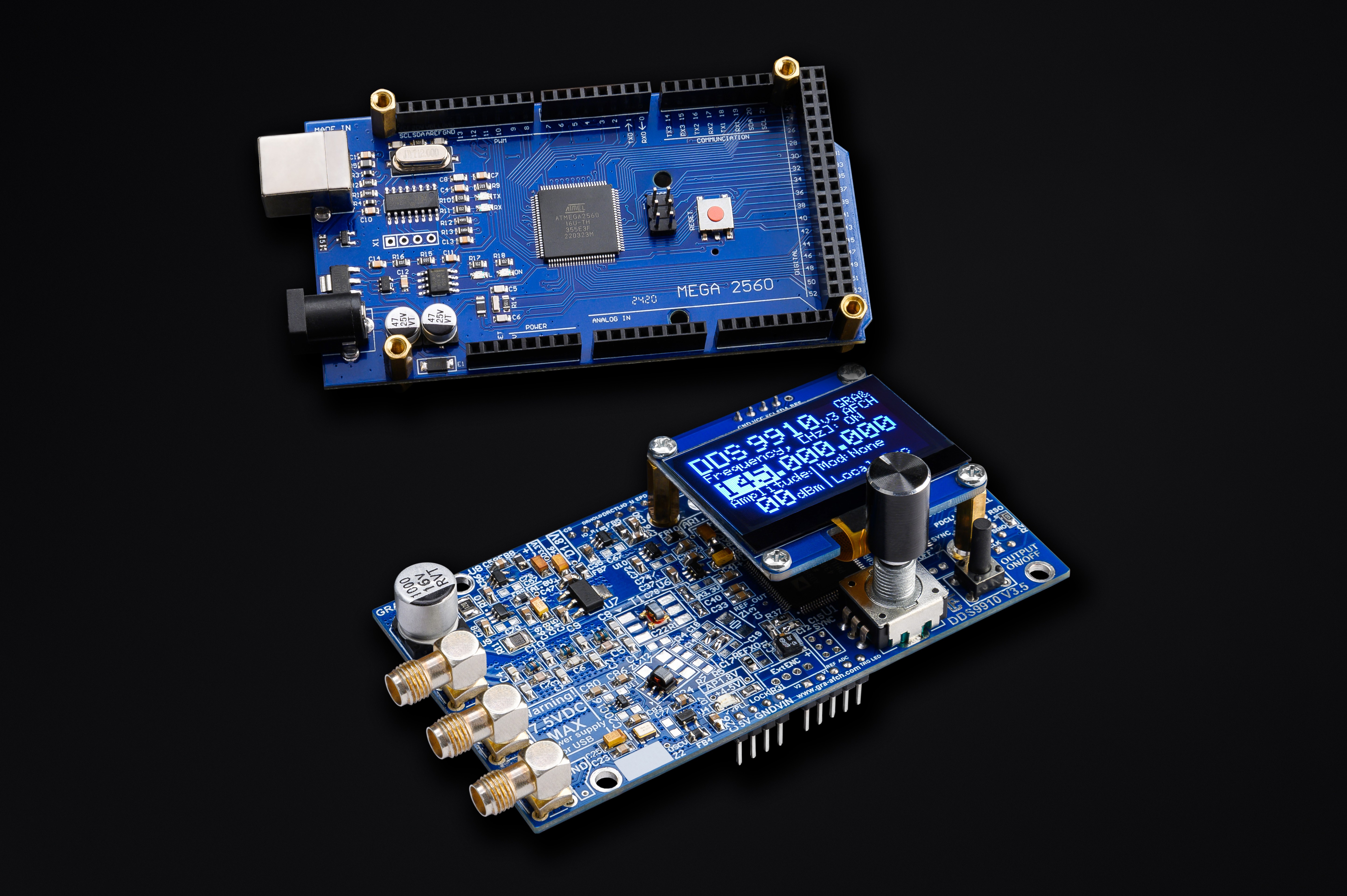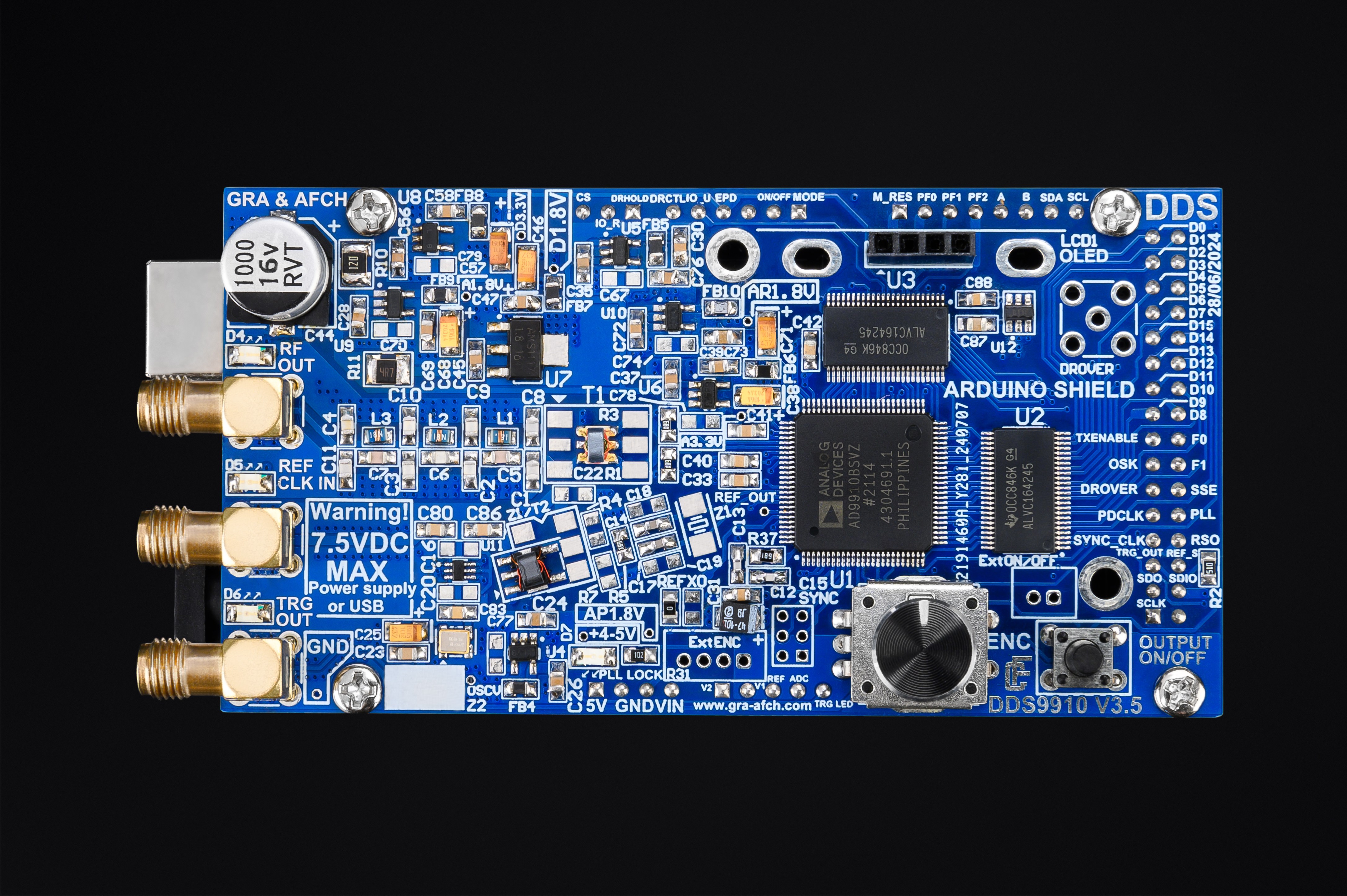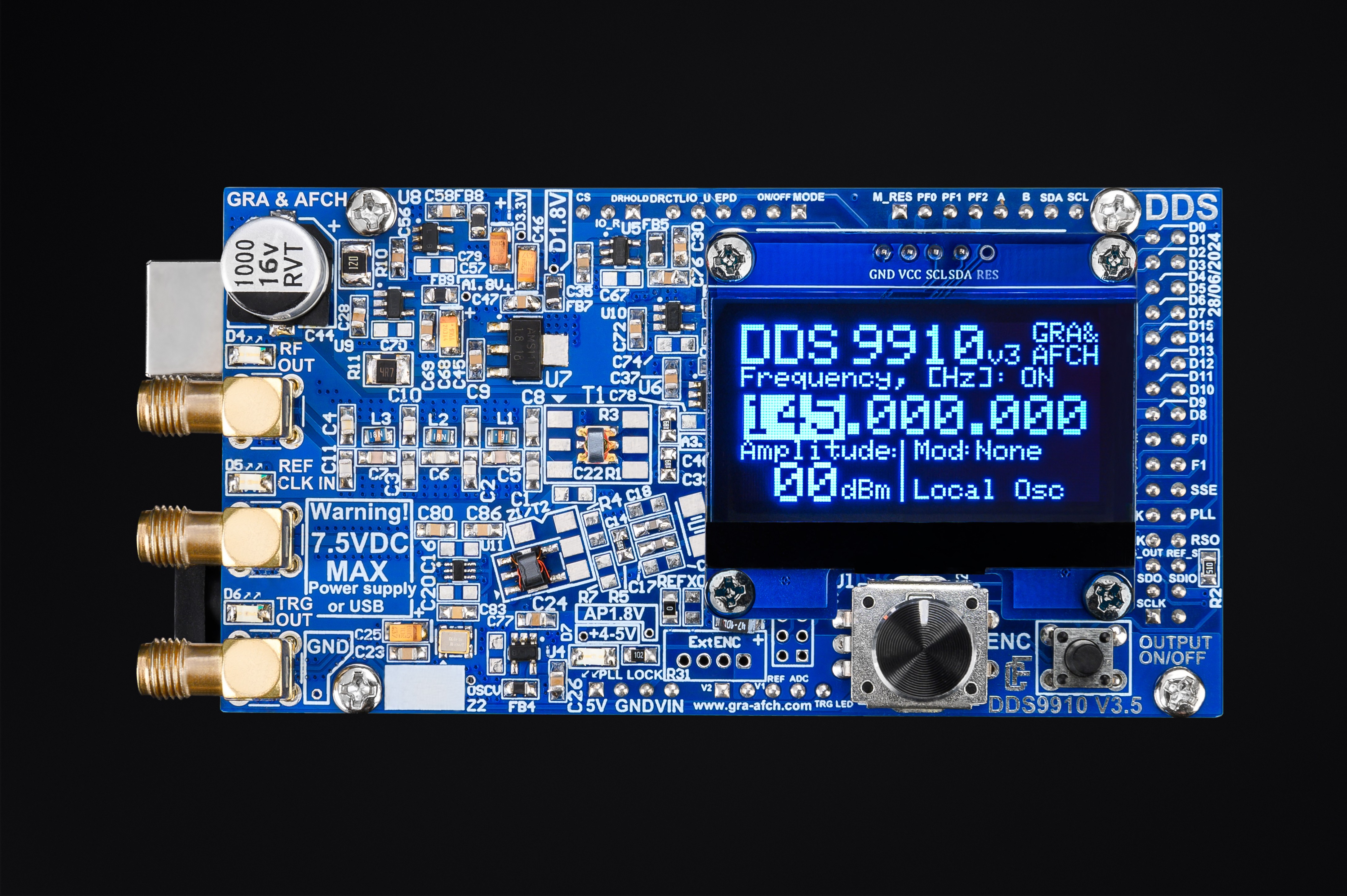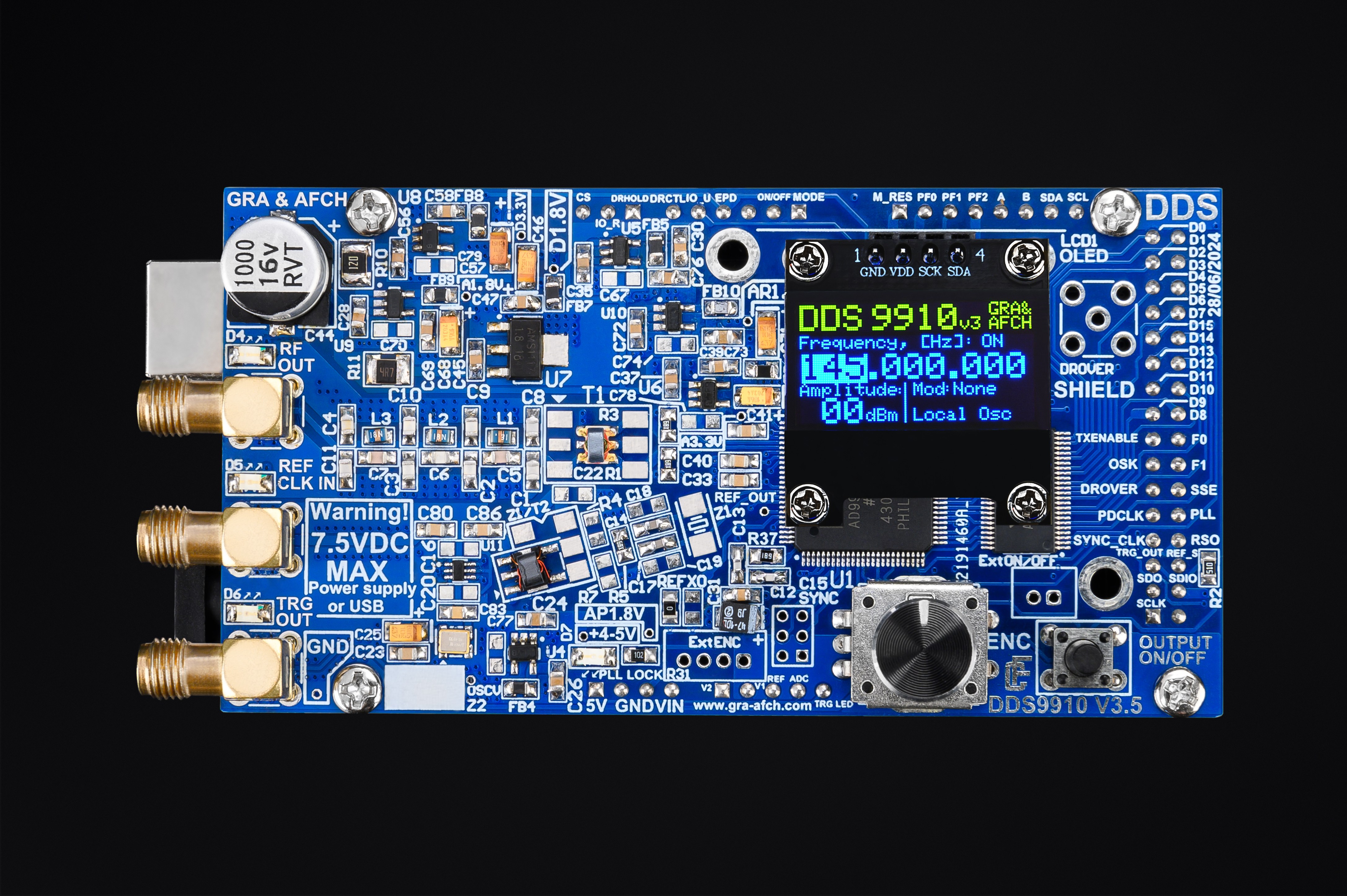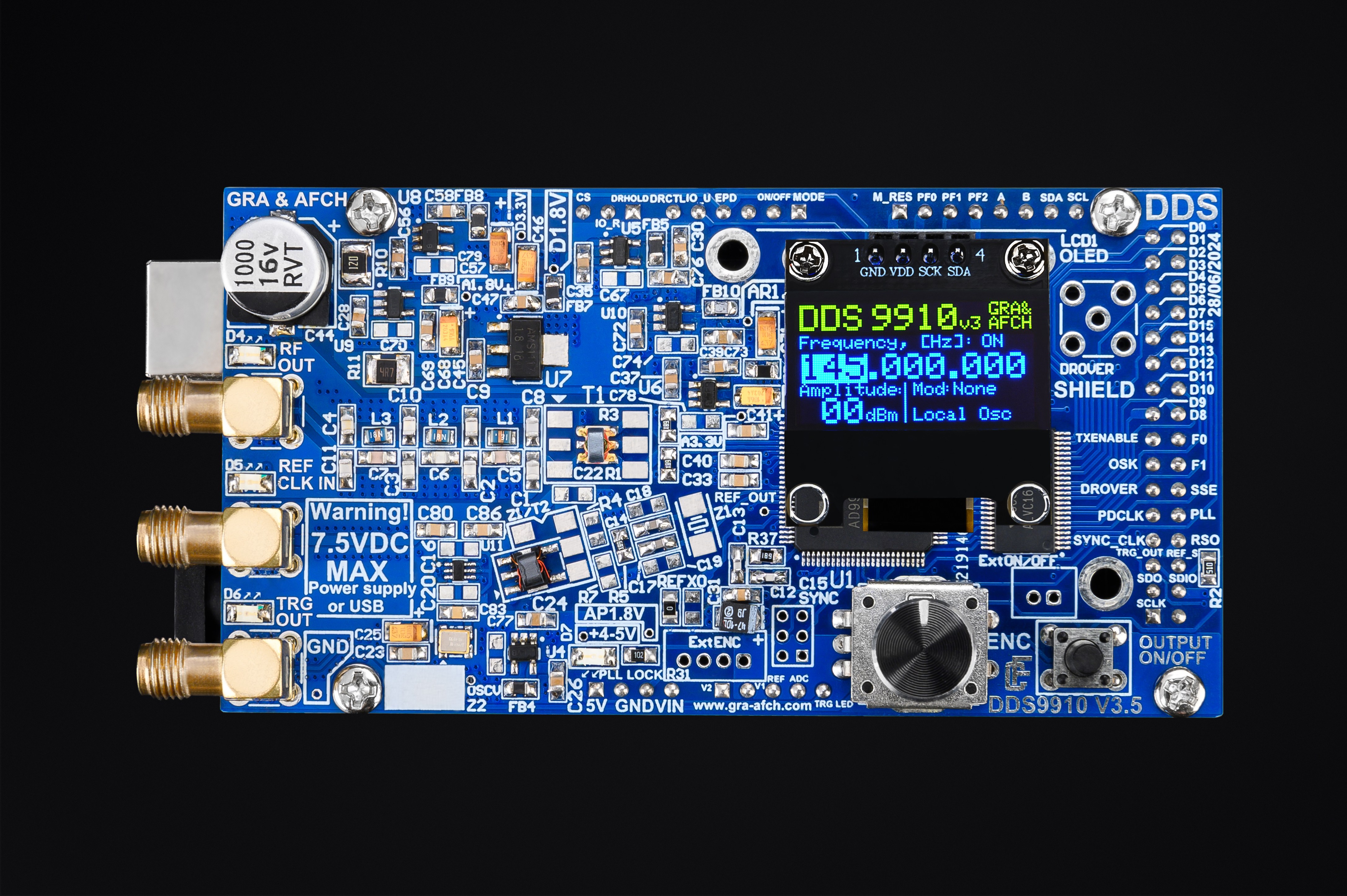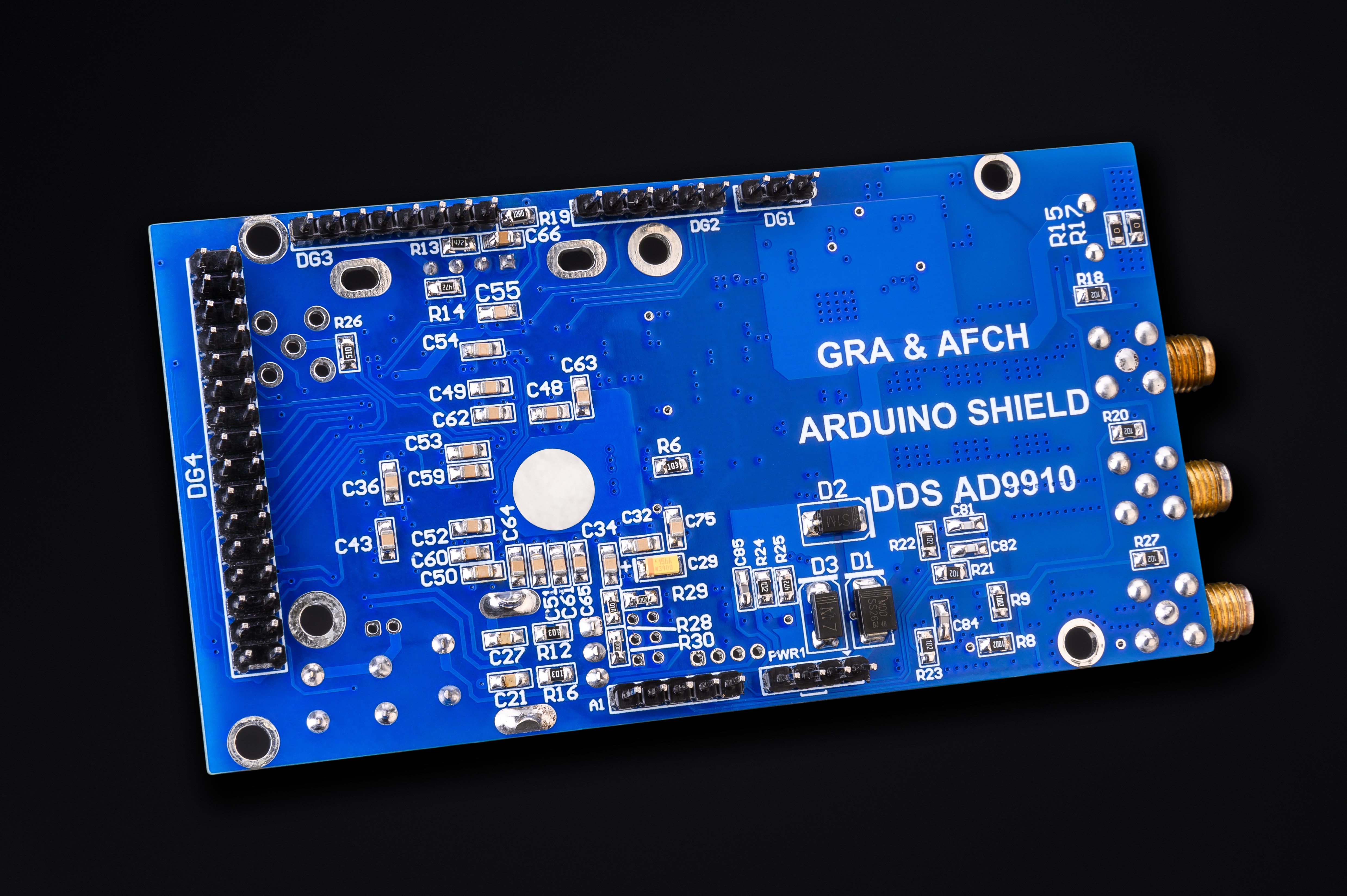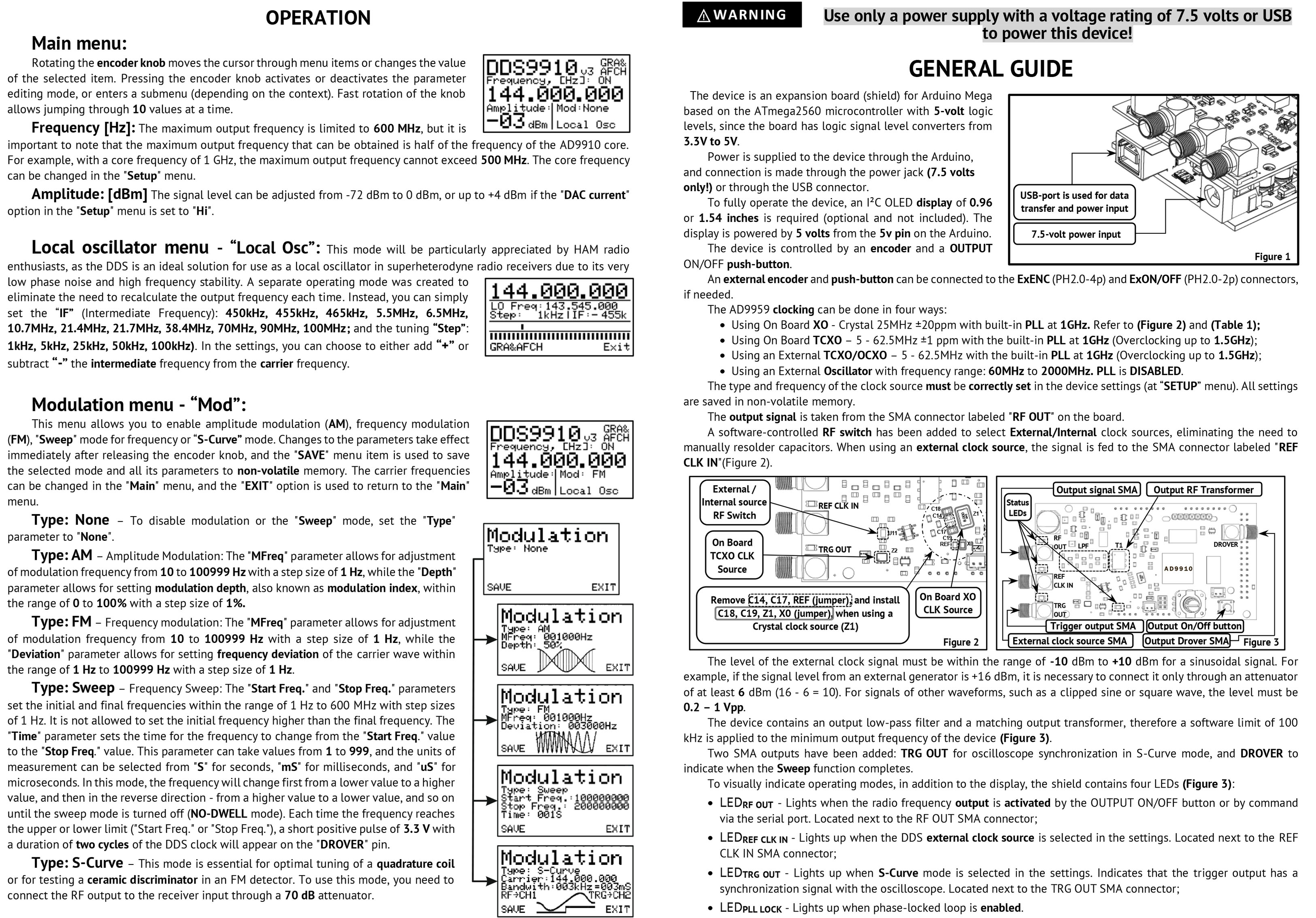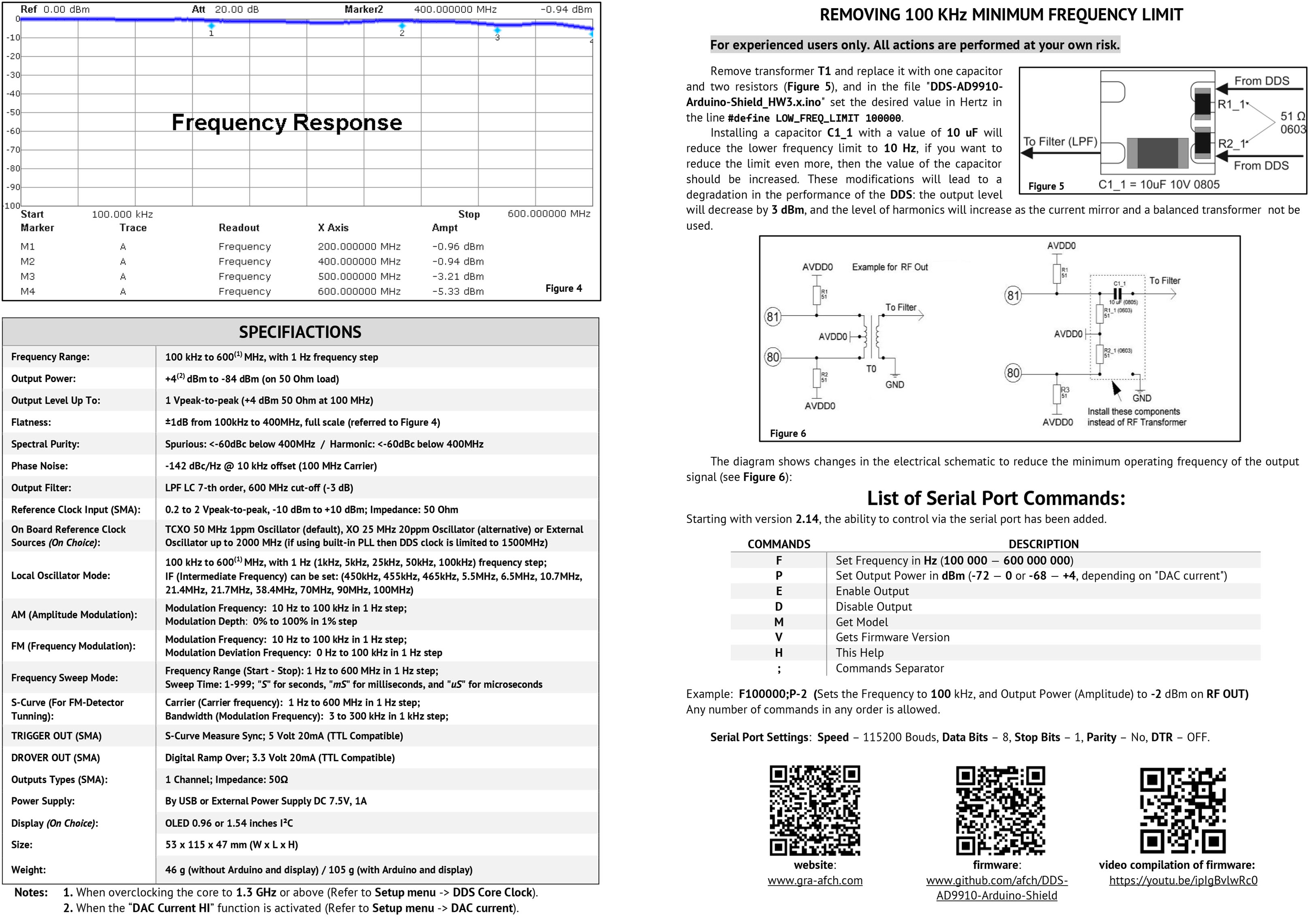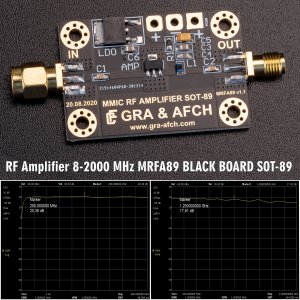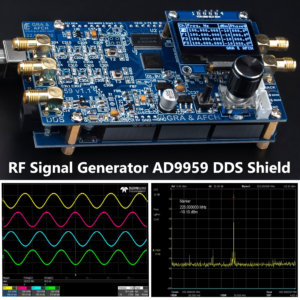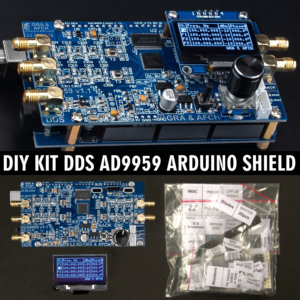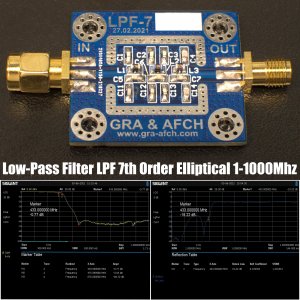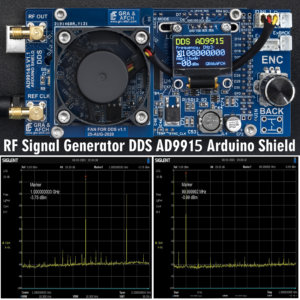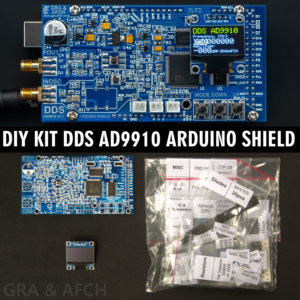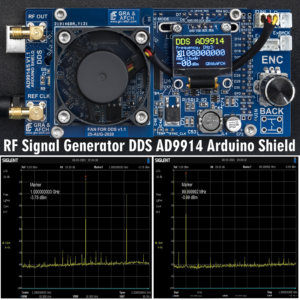DDS AD9910 v3 Shield for Arduino RF Signal Generator AM/FM/SWEEP [600 MHz, @1.5 GHz Core Clock, Low Spurs, Low Harmonic]
Units Sold: 86
DDS (Direct Digital Synthesis) Analog Devices AD9910 Shield for Arduino
This device is designed to ensure seamless integration with Arduino MEGA 2560
It does not require any extra wires or converters to work properly
For maximum performance we recommend Ultra-low noise reference oscillator RCLN1000
All functions of the DDS AD9910 are brought to the contacts from the Arduino MEGA
With this you can fully reveal all the capabilities of the DDS AD9910 Shield
PCB Design Schematics Case and Software made by GRA & AFCH
$209.95 – $289.95
DDS AD9910 Shield for Arduino RF Signal Generator
DDS9910 Shield Board is an Evaluation Board designed to utilize Analog Devices AD9910 chip capabilities
This RF AD DDS Unit specifically developed and designed to work with Arduino MEGA 2560 without additional wires or converters
The Shield Board is equipped with all linear power supplies enabling it to be powered via USB or a 7.5V power source, allowing “out of the box” functionality
It is design as product with an intuitive interface, making it easy to use for both beginners and professionals
When ordering, you can choose a Clock source option: XO/TCXO/EXT OSC (External Clock)
We recommend selecting the TCXO option, as it offers excellent phase noise and frequency stability characteristics
However the device also supports operation from an external clock source without any issues
For maximum performance we recommend using the RCLN1000 reference oscillator with ultra-low noise
This Evaluation Board is an ideal choice for developers looking to leverage the capabilities of Direct Digital Synthesis in their Arduino-based projects
The Board is suitable for students, researchers, laboratories, embedded system developers, radio enthusiasts, and HAM radio operators
The Firmware included with the Shield Board implements AD9910 technologies such as:
Sweep, DRG (Digital Ramp Generator), RAM, AM, FM modulation, S-Curve, Local Oscillator (for HAM Radio and Receiver)
PCB Design Layout Schematics Case and Software developed by GRA & AFCH
Opensource Firmware available on our GitHub repository: github.com/afch/DDS-AD9910-Arduino-Shield
DDS AD9910 Firmware compilation and uploading to Arduino Mega Tutorial: youtube.com/watch?v=Zn1xLlvlVXE
Video review of DDS AD9910 Shield on our YouTube channel: youtube.com/watch?v=GNM5LJT_cgw

Listing includes:
- RF AD DDS Unit [AD9910 Shield Board]
- Display [OLED] (0,96″ or 1,54″) (optional, choose in selector)
- Clock Source (XO, TCXO, EGEN) (optional, choose in selector)
- Arduino Control Board [MEGA 2560] (optional, choose in selector)
- Power Supply [DC 7.5V/2A] [US, EU, UK] [AC plug] (optional, choose in selector)
we cogently recommend using
Low-Pass Filters and RF Amplifiers
with our DDS AD RF Shields:
RF Amplifier 8-2000 MHz, GAIN = 20 dB, P = +20 dBm MMIC MRFA89 SOT-89 [GOLD PLATED]
for optimal DDS performance
we recommend using high stability
Low Phase Noise external Oscillators:
RCLN1000D-222 1GHz Ultra Low Phase Noise Reference Oscillator -150 dBc/Hz @ 20kHz
RCLN1000S 1GHz Low Phase Noise Reference Oscillator -139 dBc/Hz @ 10kHz
Custom design:
We are offering custom design development for this Unit for 1200$
This comes with condition that at least 10 pieces of them will be ordered then
If you have ANY questions, PLEASE ASK us.
The most significant improvements compared to the previous version:
- Menu navigation has been upgraded: buttons have been replaced with an encoder for easier control
- A physical button has been added to toggle the RF output on and off
- LED indicators have been introduced for each SMA connector, along with a separate indicator for PLL LOCK status
- Support for a larger 1.54-inch display for users with impaired vision. The 0.96-inch display remains available
- A software-controlled RF switcher has been added to select clock sources, eliminating the need to manually re-solder capacitors
- Two new SMA outputs have been added:
TRG OUT for oscilloscope synchronization in S-Curve mode, and DROVER to indicate when the Sweep function completes - A bidirectional level shifter has been added to the shield, allowing not only data writing to the AD9910 but also reading it back.
This enables the use of the “read-modify-write” concept - Two new modes have been added to the firmware: Local Oscillator and S-Curve, both useful for tuning radio receivers
- The shield now monitors the power supply voltage and displays a warning, disabling the AD9910 if the input voltage is outside acceptable limits
- Circuit design optimizations have significantly reduced phase noise compared to version 2
Key features:
- Low harmonics no more than -60dBc. An output RF transformer is used for the correct operation of the current mirror
- Low number of spurs due to the use of a 7-order output LPF filter with a cutoff frequency of 600 MHz
- 4 layer board. Signal lines TOP and Bottom, inner layers Ground and Power
- Low Noise LDO Stabilizers
- Separate power supply for all analog and digital lines (1.8V and 3.3V), 5 pcs IC voltage stabilizers are used
Additionally, there is an RF Ferrite bead interchange - High-speed decoupling Level converter and TTL 5V matching
Types of reference oscillators (optional, choose in selectors):
- XO – Crystal 20 or 25 MHz ±20 ppm internal oscillator with PLL at 1 GHz
- TCXO – 5-62.5MHz ±1 ppm internal oscillator with PLL at 1 GHz
- Ext TCXO/OCXO – 5MHz – 62.5MHz ±1ppm external oscillator with the built-in AD9910 PLL enabled at 1 GHz(Overclocking up to 1.5 GHz)
- EXT OSC – external reference oscillator from 60 MHz up to 2 GHz (when the divider is set in the settings), NOT INCLUDED
- Additionally balancing transformer is used for TCXO/OCXO and EXT OSC options
Functional features:
- Easy to connect OLED display
- Rotary Encoder for control via the program menu
- The firmware allows you to select and configure the frequency of the clock generator through the user menu
(without the need to recompile the program) - Any settings can be stored in non-volatile EEPROM memory (located at Arduino Mega)
- Basic settings are applied and saved automatically
- Expanded and convenient DDS clock source menu
- Offset parameter allows adjusting the clock frequency if the deviation from the specified value
- This shield support overclocking the AD9910 core to 1.5 GHz (heatsink is recommended)
- DDS AD9910 Shield has ability to generate a signal up to 600 MHz with a core overclocking up to 1.5 GHz
(to suppress harmonics it is recommended to overclock the AD9910 for frequencies above 400 MHz) - It is possible to obtain a low frequency at the DDS output from 10 Hz (modification required, see instructions below)
- Has ability to increase output power by +4 dBm when “DAC Current HI” is activated
- Enabling and disabling the output with a simple “OUTPUT ON/OFF” button press, confirmed by an indication on the OLED screen
Electrical performance:
- Ensured low harmonic level with levels not exceeding -60dBc,
this is due to the use of an output RF transformer for optimal current mirror operation - Low-noise LDO stabilizers: 7 pieces of IC voltage regulators are used
- Separate power supply for all analog and digital lines (1.8 and 3.3V).
Ferrite beads are also installed on each power line to isolate the power lines from each other - 4 layered PCB with signal lines on Top and Bottom and inner layers Ground and Power
- High-speed decoupling Level converter and TTL 5V matching
- Remote control of the DDS Generator through a USB connection and PC using the terminal serial port
Specifications:
| Frequency: | 100 kHz – 420 MHz (600 MHz*) |
| Spurs max: | -60 dBc |
| Frequency step: | 1 Hz |
| Output power: | +0 dBm (+4**) to -84 dBm (on 50 Ohm load) |
| Output level up to: | 1 V peak-to-peak (at +4 dBm) |
| Phase noise: | -142 dBc/Hz @ 10 kHz offset (100 MHz Carrier) |
| Output filter: | LPF LC 7th Order 600 MHz cut-off (-3 dB) |
| Modulation frequency for AM (Amplitude modulation): | 10 Hz to 100 kHz in 1 Hz step |
| AM modulation depth: | 0% to 100% in 1% increments |
| Modulation frequency for FM (Frequency modulation): | 10 Hz to 100 kHz in 1 Hz step |
| FM modulation deviation frequency: | 0 Hz to 100 kHz in 1 Hz step |
| Reference clock sources (on choice): | XO-Crystal Oscillator, TCXO 1ppm, External OCXO 0.1ppm, or External Oscillator up to 2 GHz |
| Reference clock Input Level (MIN): | 100 mVp-p or -16 dBm |
| Reference clock Input Level (MAX): | 2000 mVp-p or 10 dBm |
| Trigger output level (TRG OUT): | 5V |
| S-Curve Time to Frequency correspondence: | 1 ms corresponds to 1 kHz detuning |
| S-Curve Bandwidth: | 3 kHz – 300 kHz, step 1 kHz |
| Local Oscillator mode IF list (±): | 450 kHz, 455 kHz, 465 kHz, 5.5 MHz, 6.5 MHz, 10.7 MHz, 21.4 MHz, 21.7 MHz, 38.4 MHz, 70 MHz, 90 MHz, 100 MHz |
| Power requirements: | USB or External Power Supply 7.5V DC 1A |
| Shield Board size: | 53 x 102 х 32 mm |
* When overclocking the core to 1.5 GHz
** When the “DAC Current HI” function is activated
If you have ANY questions, PLEASE ASK us.
Phase Noise:
This parameter is very important and interesting for those who wants to buy DDS.
Since the intrinsic phase noise of DDS is obviously less than that of PLL generators, the final value is highly dependent on the clock source.
Designing our DDS AD9910 Shield for Arduino we strictly adhered to all recommendations from Analog Devices.
This was done In order to achieve the values stated in the datasheet for the AD9910.
Among these are PCB layout in 4 layers, separate power supply of all 4 power lines (3.3 V digital, 3.3 V analog, 1.8 V digital, and 1.8 V analog).
Figure below shows the phase noise level when using the built-in PLL in DDS.
The PLL multiplies the frequency of the on-board 50 MHz TCXO generator by a factor of 20. The output frequency is 100 MHz.
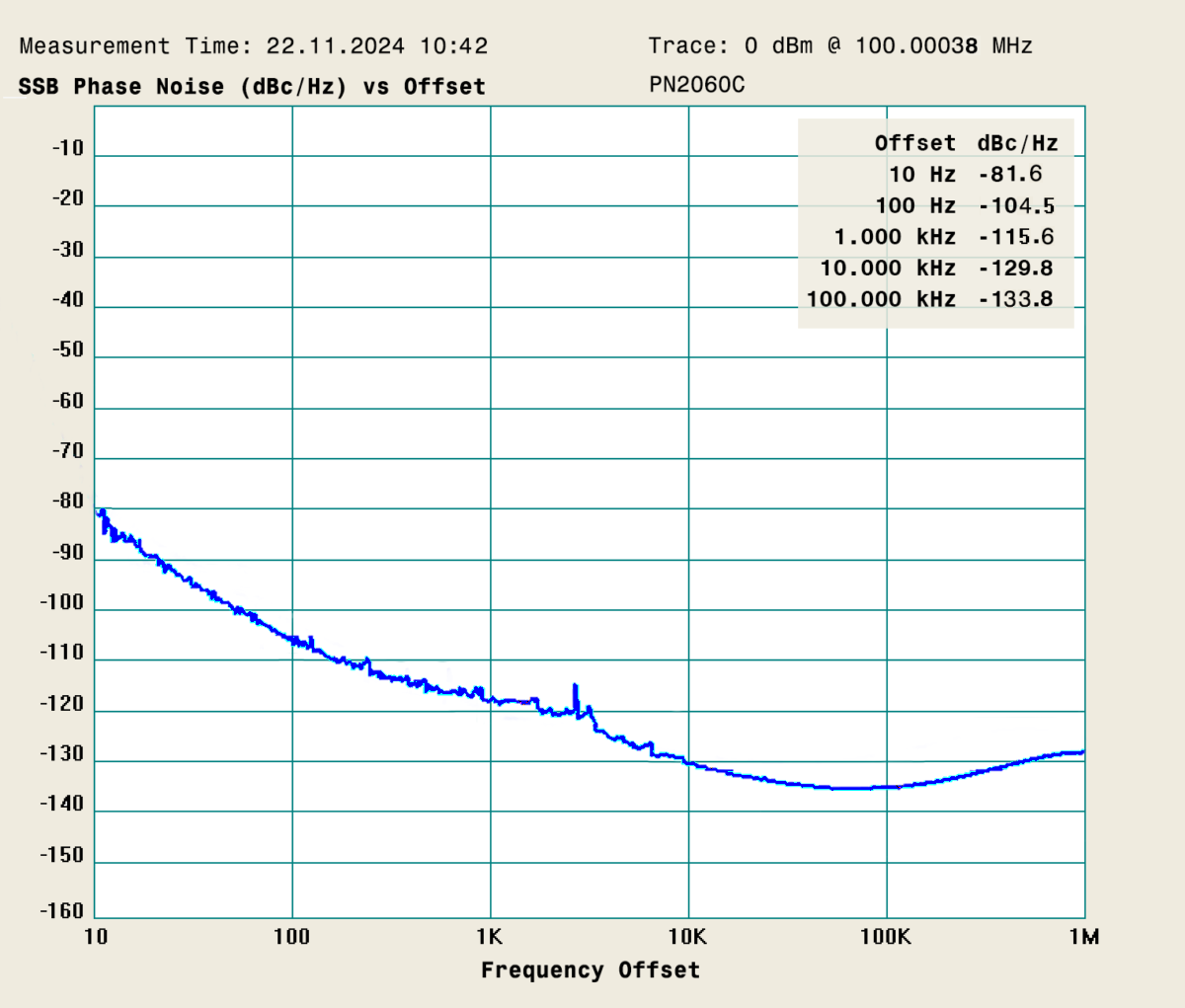
Figure below shows the phase noise level when using an external reference clock frequency of 1 GHz (RCLN1000), with the PLL OFF.
The output frequency of the DDS is 100 MHz.
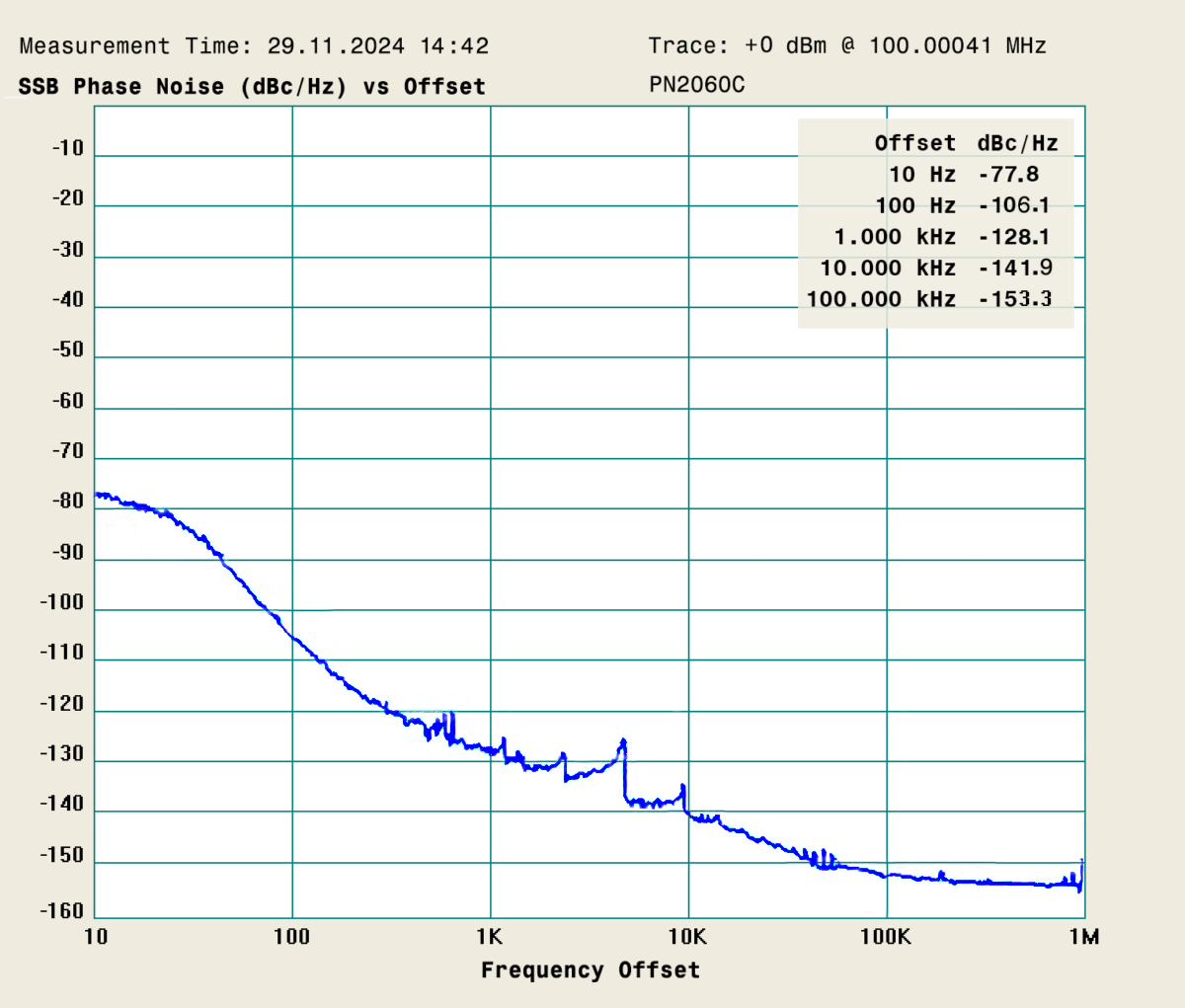
Let’s compare these two graphs, for example, at a 10 kHz offset from the carrier: with the internal PLL system engaged,
the phase noise level is -130 dBc/Hz, while with the PLL system disengaged and using external clocking, the phase noise is -142 dBc/Hz.
This means that using an external clock signal results in a phase noise that is 12 dBc/Hz better (lower).
For the same output frequency, but at a 1 MHz offset from the carrier, with the internal PLL system engaged,
the phase noise level is -125 dBc/Hz, while with the PLL system disengaged and using external clocking, the phase noise is -155 dBc/Hz.
This means that using external clocking results in phase noise that is 30 dBc/Hz better (lower).
Conclusion:
When using external clock, you can get much lower phase noise than using the built-in PLL.
But do not forget that in order to achieve such results, increased requirements are put forward to the external oscillator.
For maximum performance we recommend our Ultra-low noise reference oscillator 1GHz RCLN1000.
Ultra Low Noise Reference Oscillator for AD9910 Shield:
1GHz Ultra Low Noise Reference Oscillator -130dBc/Hz @ 10kHz RCLN1000 for DDS AD9910 DDS9912 Units
If you need higher power output:
The first and simplest method to increase the power from the nominal 0 dBm to +4 dBm is by activating the “Hi-Current” option in the menu (refer to Operation instruction).
NOTE: enabling this setting leads to increase in harmonic levels of the output signal.
If this level of power is still insufficient, there is a second method – connecting an external RF signal Amplifier, such as the MMIC MRFA89.
It allows obtaining a DDS signal output power of up to +20 dBm.
IMPORTANT: Since the MMIC MRFA89 Amplifier has maximum output power of +20 dBm and gain of 20 dB, the recommended maximum input signal level is 0 dBm.
Therefore, the ‘Hi-Current’ parameter should be deactivated in the AD9910 Shield menu.
NOTE: as most amplifiers generate harmonics, it is advised to connect an LPF Filter to the Amplifier output for harmonic suppression.
For example, one from the LPF 7th Order Elliptical series that we offer.
Amplifier and Filter for AD9910 Shield:
RF Amplifier 8-2000 MHz, GAIN = 20 dB, P = +20 dBm MMIC MRFA89 SOT-89 [GOLD PLATED]
OLED Display Menus:
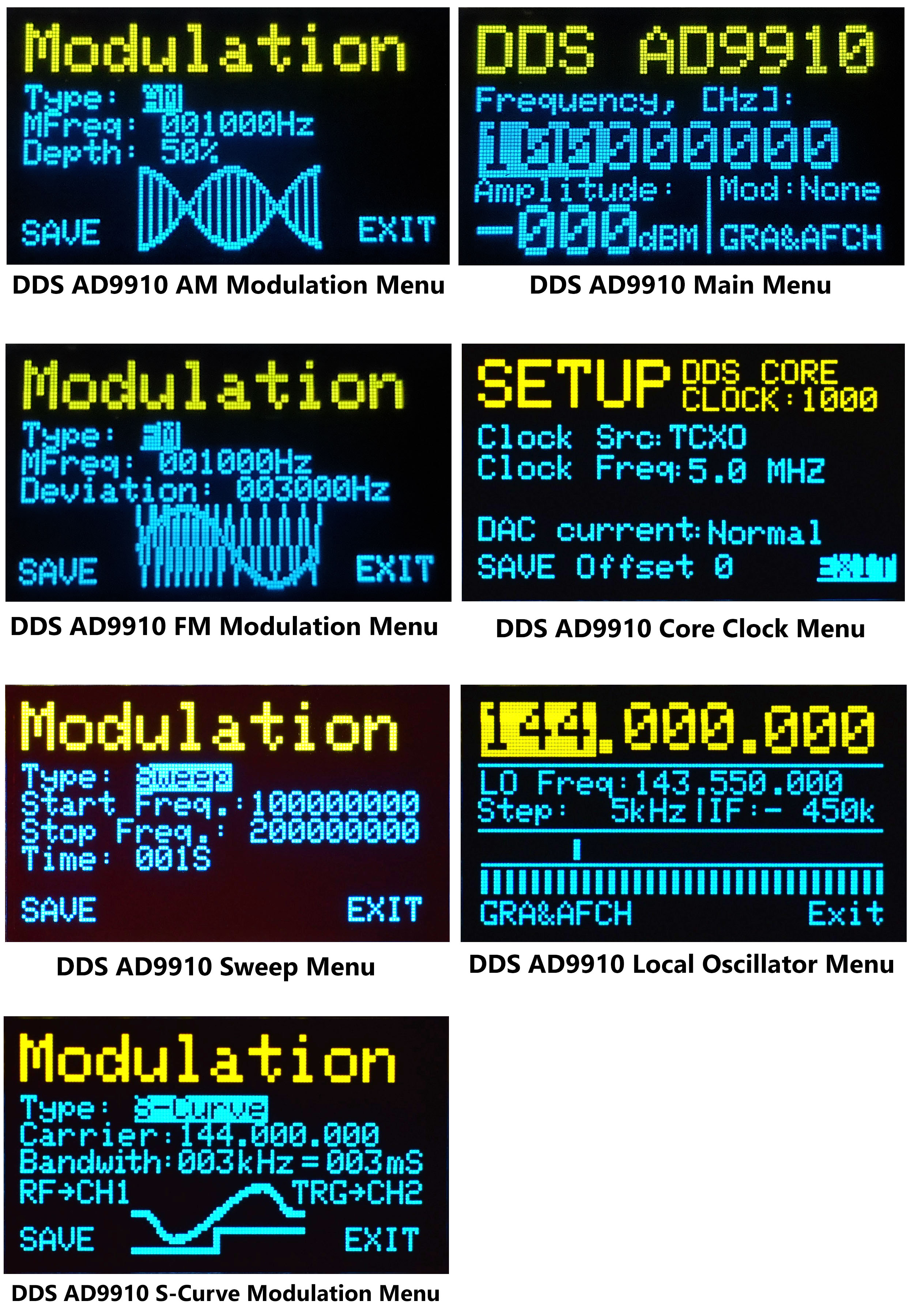
The switching of clock sources:
The switching of clock sources is performed through the clock menu and is handled by an onboard software-controlled commutator.
It does not require installing or removing any components on the board to switch between any clock sources except the XO (Crystal Oscillator).
For clocking from the XO (Crystal Oscillator), in addition to activating the corresponding setting in the software menu, the installation of several components will also be required.
See the table below:
| Clock source | Capacitors (0805) | Resistors (0R 0805) | ||
|---|---|---|---|---|
| C18, C19 (33pF) | C14, C17 (100nF) | XO | REF | |
| XO – Crystal Oscillator (20, 25 MHz) | V | X | V | X |
| TCXO, Ext. TCXO/OCXO, Ext OSC | X | V | X | V |
Where V means that the component must be installed (soldered), and X – means that the component must be removed
Remote control of DDS Generator through USB connection from PC using the terminal serial port:
List of Serial Port Commands:
Starting with version 1.02, the ability to control via the serial port has been added.
F – Set Frequency in Hz (100000 – 600000000)
P – Set Output Power in dBm (-72 — 0 OR -68 — +4, depending on “DAC current”)
E – Enable Output
D – Disable Output
M – Get Model
V – Get Firmware Version
h – Help
; – Commands Separator
Example:
F100000;P-2
Set Frequency to 100 kHz, and Output Power to -2 dBm.
Any number of commands in any order is allowed.
Serial Port Settings:
Speed – 115200 Bouds
Data Bits – 8
Stop Bits – 1
Parity – No
DTR – OFF
Windows:
An example of setting up a serial port in the Windows console:
mode COM3 baud=115200 DTR=OFF Data=8
Usage example:
echo F100000000 > COM3
Ubuntu 22.04:
An example of setting up a serial port in the Ubuntu:
sudo usermod -aG dialout $USER_NAME$
sudo chmod a+rw /dev/ttyUSB0
sudo stty -F /dev/ttyUSB0 115200 cs8 ixoff -hupcl -echo
Usage example:
echo “F100000000” > /dev/ttyUSB0
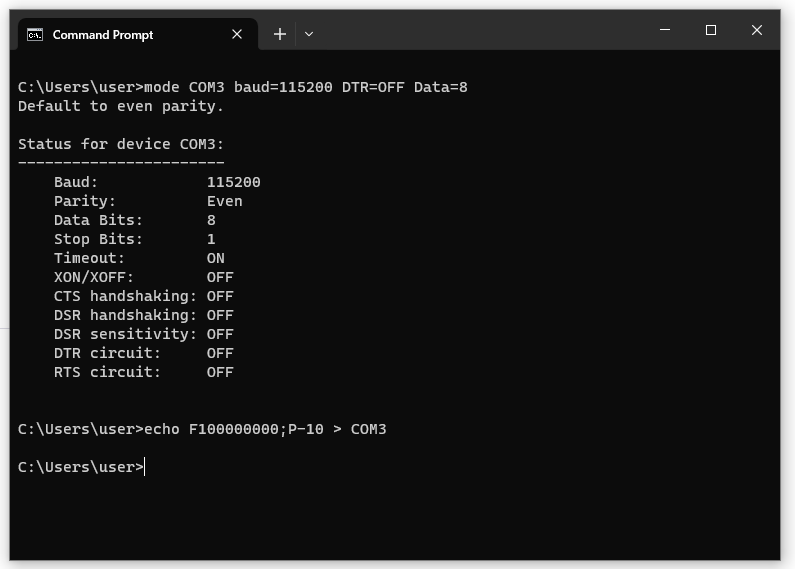
example of command prompt with serial commands for AD9910 DDS RF Unit
DDS AD9910 Shield for Arduino Spectrograms:
GRA & AFCH DDS AD9910 Shield VS DDS Board from China Spectrograms Comparison:




GRA & AFCH DDS AD9910 Shield Spectrograms:
 500 MHz, DAC Current set to “HI”-600 MHz, DAC Current set to “HI”
500 MHz, DAC Current set to “HI”-600 MHz, DAC Current set to “HI”
 AM (Amplitude Modulation) Modulation Freq: 1kHz, Depth: 50%-FM (Frequency Modulation) Frequency: 1 kHz Deviation: 3 kHz
AM (Amplitude Modulation) Modulation Freq: 1kHz, Depth: 50%-FM (Frequency Modulation) Frequency: 1 kHz Deviation: 3 kHz

AM (Amplitude Modulation) Carrier: 1 MHz Frequency: 100 kHz Depth: 50%
DDS AD9910 Shield for Arduino Thermal images:
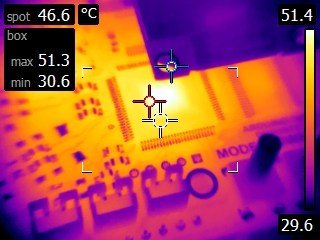
AD9910 Board temperature measured with Flir E8 thermal imager at Core Clock @ 1000 MHz
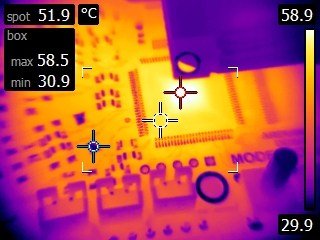
AD9910 Board temperature measured with Flir E8 thermal imager at Core Clock @ 1440 MHz
DDS AD9910 Shield Board Connection Diagram:
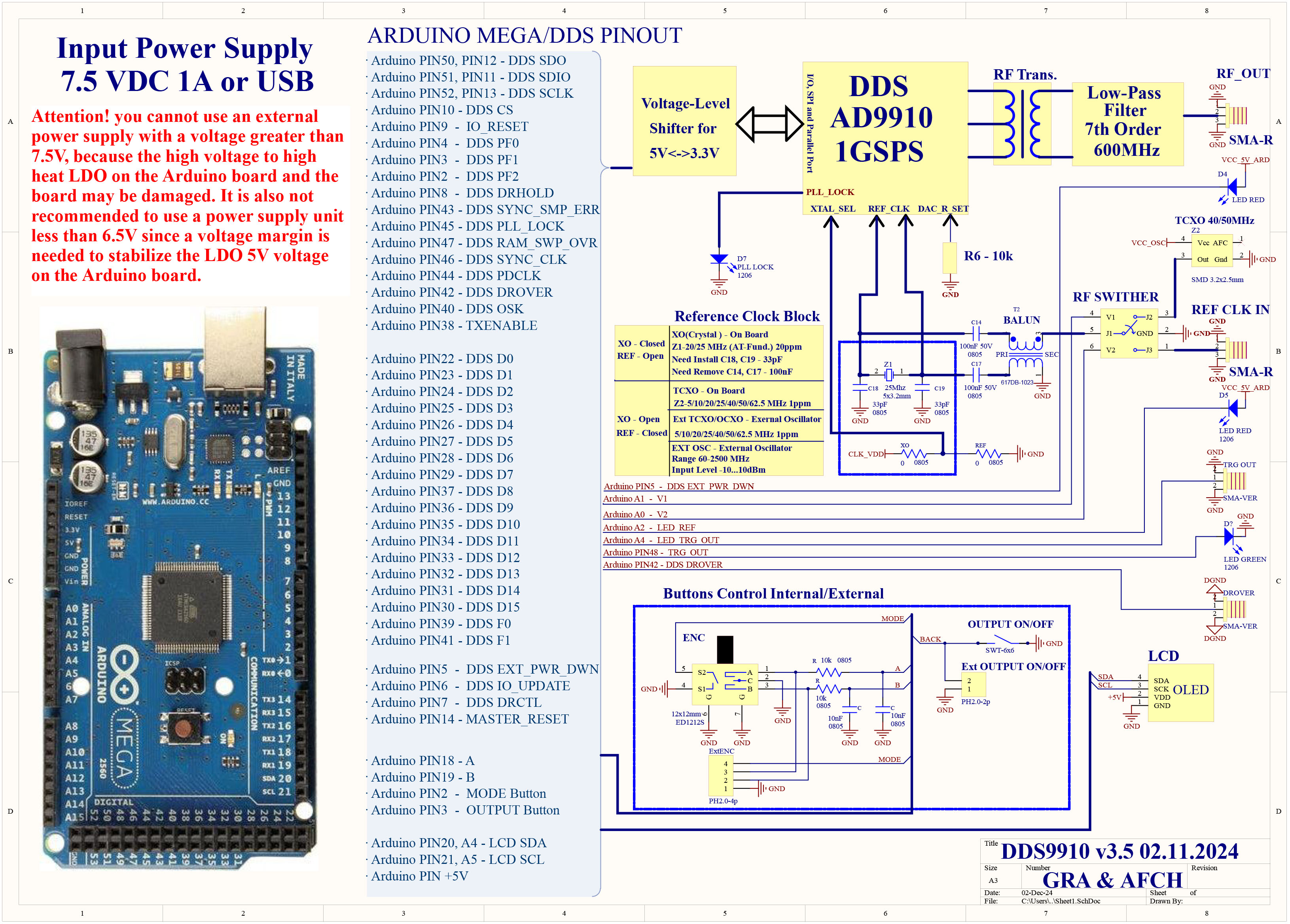
DDS AD9910 Shield for Arduino by GRA & AFCH:
DDS AD9910 Shield Firmware compilation and uploading to Arduino MEGA:
DDS AD9910 Shield RF Signal Generator by GRA & AFCH:
Operating Manual
If you have ANY questions, PLEASE ASK us.
You may also like…
DDS AD9959 Arduino Shield RF Signal Generator 4 Synchronized DDS Channels [225MHz, @600 MHz Core Clock, Low Spurs, Low Harmonic]
DDS (Direct Digital Synthesis) Analog Devices AD9959 4 Synchronized DDS Channels
Arduino Shield Easy connection to Arduino MEGA 2560 without additional wires and converters
All functions of the DDS AD9959 are brought to the contacts of the Arduino MEGA
With this you can fully reveal all the capabilities of the DDS AD9959 Shield
PCB, Design, Schematics, Case and Software made by GRA & AFCH$189.95 – $269.95 Select optionsDIY KIT for DDS AD9959 Arduino Shield RF Signal Generator 4 Synchronized DDS Channels [225MHz, @600 MHz Core Clock, Low Spurs, Low Harmonic]
DIY KIT for DDS (Direct Digital Synthesis) Analog Devices AD9959 4 Synchronized DDS Channels
Arduino Shield Easy connection to Arduino MEGA 2560 without additional wires and converters
All functions of the DDS AD9959 are brought to the contacts of the Arduino MEGA
With this you can fully reveal all the capabilities of the DDS AD9959 Shield
PCB, Design, Schematics, Case and Software made by GRA & AFCH$219.95 – $299.95 Select optionsLow-Pass Filter LPF 7th Order Elliptical 1-1000Mhz 3.5, 7, 14, 28, 144, 433MHz etc for RF Amlifier, Receiver, Transmitter, Mixer, Transceiver, Antenna.
Low-pass Filter is a filter that passes signals with a frequency lower than a selected cutoff frequency
It than also attenuates signals with frequencies higher than the cutoff frequency
These filters are usually applied after RF amplifiers like MMIC, Gain-block and Class C amplifiers
It is used for suppression of high-order harmonics of radio-frequency signals
They can also be placed at the mixer output to filter high frequency interference that plays a role in frequency selection$18.95 – $69.95 Select optionsDDS AD9915 Arduino Shield RF Signal Generator [1GHz @3GHz Core Clock, Low Spurs, Low Harmonic]
DDS (Direct Digital Synthesis) Analog Devices AD9915
Arduino Shield Easy connection to Arduino MEGA 2560 without additional wires and converters
All functions of the DDS AD9915 are brought to the contacts of the Arduino MEGA
With this you can fully reveal all the capabilities of the DDS AD9915 Shield
PCB, Design, Schematics, Case and Software made by GRA & AFCH$599.95 – $679.95 Select optionsDIY KIT for DDS AD9910 Shield for Arduino RF Signal Generator AM/FM/SWEEP [600 MHz, @1.5 GHz Core Clock, Low Spurs, Low Harmonic]
DIY KIT for DDS (Direct Digital Synthesis) Analog Devices AD9910 Arduino Shield
Easy connection to Arduino MEGA 2560 without additional wires and converters
For maximum performance we recommend Ultra-low noise reference oscillator RCLN1000
All functions of the DDS AD9910 are brought to the contacts of the Arduino MEGA
With this you can fully reveal all the capabilities of the DDS AD9910 Shield
PCB Design Schematics Case and Software made by GRA & AFCH$199.95 – $279.95 Select optionsRCLN1000C – 1GHz Low Phase Noise Reference Oscillator -136 dBc/Hz @ 10kHz RCLN1000C for AD9910 AD9912 Units
The RCLN1000C Oscillator is built on a VCXO and a high-speed comparator
It generates clean rectangular CMOS signal
This approach enables precise odd-order frequency multiplication
It is implemented in this design by a factor of 5 without introducing additional phase noise
To further improve frequency accuracy the oscillator incorporates a Phase-Locked Loop (PLL)
with a Temperature-Compensated Crystal Oscillator (TCXO) as the reference
It ensuring outstanding stability and reliability across a wide temperature range
$299.95 – $314.95 Select optionsDDS AD9914 Arduino Shield RF Signal Generator [1.4GHz @3.5GHz Core Clock, Low Spurs, Low Harmonic]
DDS (Direct Digital Synthesis) Analog Devices AD9914
Arduino Shield Easy connection to Arduino MEGA 2560 without additional wires and converters
All functions of the DDS AD9914 are brought to the contacts of the Arduino MEGA
With this you can fully reveal all the capabilities of the DDS AD9914 Shield
PCB, Design, Schematics, Case and Software made by GRA & AFCH$699.95 – $904.95 Select options


